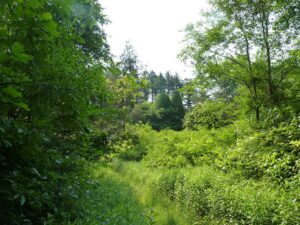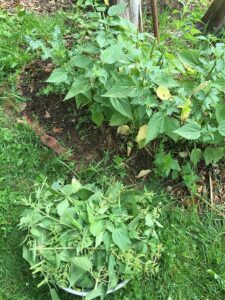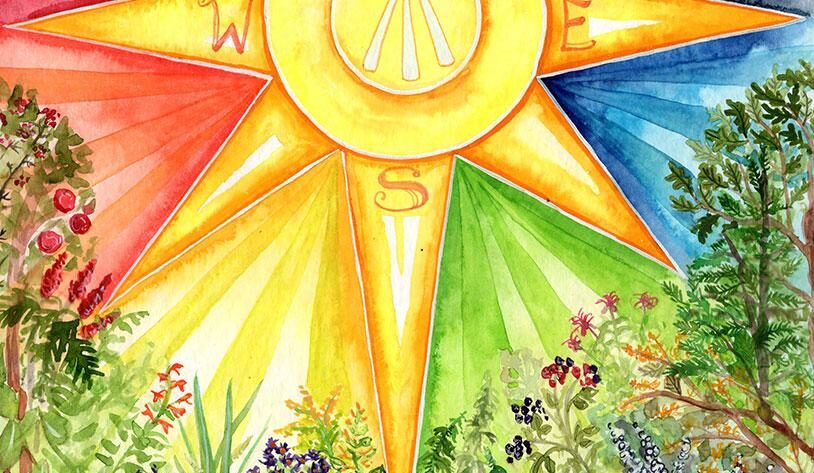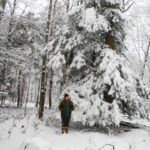A druid walks upon a landscape, barren, cold, with trees cut and plants uprooted. Tears in her eyes, she surveys the damage that others have caused: the homes of so many animals disrupted after logging, the wild ramps and ginseng roots damaged, and the remains of the logged trees laying like skeletons on the earth. But she is called to this place, to work with it, to embrace it, to help aid in the healing work that nature is already so good at doing. Rather than look away, the druid embraces this damaged land and begins, slowly, the work of regeneration.
Five years later, the druid walks again upon this same landscape at Beltane. The sacred grove she established is blooming with hawthorns, ashes, and maples surrounding small stones she set to hold the space. Wild ramps are abundant on the forest floor, and black and blue cohosh poke up from the soil, leaves starting to unfurl. The young trees planted are growing tall. Turkey tail mushrooms cover the old stumps, producing amazing medicine as the fallen trees return to soil. Forest hugelkultur mounds of raspberries and currants surround the edges of the space. In a few short years, with a lot of hard work, the druid has worked with nature to speed up nature’s own healing processes–while this space would have healed without her, her intervention allowed healing to happen much faster. And through this work, she has gained a much deeper connection with nature and her spirits. As the druid worked with nature to regenerate this landscape, old wounds of her own were healed and soothed.
This opening story offers one viewpoint on the work of regeneration–the theme for Beltane in my 21st Century Wheel of the Year. Regeneration, in its most basic definition, is restoring something to wholeness, bringing something back into health and abundance, and restoring something back to its original functioning. Regeneration is a particularly important concept for those of us practicing nature spirituality to embrace today, where so much of human activity on the earth is harming and destroying the biosphere.
This post is part of my 21st Century Wheel of the Year series where I’m offering insights into new themes to consider for a traditional neopagan wheel of the year. I have found that as we move deeper into the age of the Anthropocene, the traditional wheel of the year no longer fits, and thus, I’ve been creating a new wheel of the year with themes more appropriate to help us navigate, respond, and do good in this difficult age. Previous posts in this series have included: Receptivity at the Fall Equinox; Release at Samhain; Restoration at the Winter Solstice, Reskilling at Imbolc, and Resilience at the Spring Equinox. Today, we continue the wheel with Regeneration at Beltane!
The Work of Regeneration: Why take up this work?

Regeneration is an extremely powerful concept that allows us to accomplish a number of good things. These include:
To work as a force of good upon the land around us. So many of the narratives we have about humanity’s role on this planet are all of the bad things we are doing. And it’s true, that humans are engaged in a lot of nature-destroying activities. However, this is not the only narrative we can have–regeneration helps us reframe our work, ourselves, and our work in the world. It allows us to help balance our actions and begin to do good on behalf of the living earth by participating directly in healing work.
To be in service to the living earth and give back. While I’ve argued that there are lots of different kinds of offerings we can make to show the earth our respect and reverence, being in service through direct regeneration of the living earth is probably the very best offering we can make. It shows nature you are serious about building a relationship and allows you to give back in the most meaningful way possible.
To deepen your connection to the living earth. One of the questions I think a lot of us ask is–how can we deepen our relationship with nature? This is an incredible way. When you involve yourself in nature’s healing, you get to learn a great deal about how nature works–watching the yearly progress of trees growing tall, watching the birds and bees returning, being able to see how nature’s magic happens. Not to mention, it helps solidify your own role in being a human being as part of the earth, not separate from her.
To heal yourself through nature’s healing. Because we are not separate from nature, as we heal nature, that healing also is reflected in ourselves. I can’t tell you how much this matters in such a difficult age!
To create a different vision of the future. Part of the reason this particularly Wheel of the Year series exists is to acknowledge that we are living in very difficult times–times when it seems everything around us consumes destroys life and produces a terrifying vision of the future. One of the direct ways I counter feeling despair and hopelessness at the challenges in this present age is through the work of regeneration. Ultimately, our actions help shape the future. By actively healing the earth, we are working on creating a different future for all life. And that’s a very, very good thing.
The Work of Regeneration: What can I do?
There is no right or wrong way to practice regeneration on the landscape, and each of us can practice it differently depending on where we are, what ecosystem we live in, if we have access to land (our own, others’, public lands), if there are community groups already doing this work, and so much more. So here, I’ll offer some common ways you can practice regeneration:
1. Find a community organization that is doing regenerative work on the landscape and volunteer. These groups may include community organizations tied to local public parks, those who are doing tree planting or native habitat restoration, or those working in other conservation areas. This is a particularly good option for those who are just starting out.
2. Get some training in permaculture design as a first step. Permaculture design focuses on using an active regenerative approach to working directly with the land, working with nature and her healing processes, and cultivating deep interaction with the living earth. One of the things that permaculture designers like to say is that we are designing for the next 1000 years! I have found that my training in Permaculture design and permaculture teaching gave me the skillset to actively regenerate my ecosystem and made me feel confident that I was working to create healing. There are now free and online options (although if you can swing it, an in-person PDC is the best). If you want to learn online, I highly recommend the courses of Heather Jo Flores.

3. Convert your lawn into a garden, meadow, or food forest. The lawn is one of the most ecological damaged spaces we have, and they are so common that we think they are “natural”. But lawns are maintained by fossil fuels, they have very little life or space for life, and their maintenance requires consumption. By converting even a small piece of an existing lawn into something else (a garden, a rain garden, a native flower meadow, a food forest) you are welcoming life back into the space.
4. Work to heal spaces nobody cares about. There are lots of abandoned spaces, spaces that could use some love and care. The abandoned lot next to the railroad tracks, the back yard of the abandoned house in your neighborhood, the boney dump site (this is my favorite one to visit), you name it. You can do a lot with seed scattering, planting trees, removing invasives, and so on.
5. Develop new pockets of life in urban environments. Urban environments are no less in need of healing than other places. Creating pockets of life and healing, whether those are community gardens, food forests, and so on can be a wonderful way to bring in the work of regeneration.
This is a very small list, but hopefully, it will get you excited to start. I also have a longer post that talks through some more specific details if you are going to do regenerative work on the land in a larger way. Finally, for some examples, please see my ongoing work on regenerating our Druid’s Garden homestead here, here, and here; an example of a lawn conversion at Nature’s Harvest Organic Farm, and an urban garden here.
The Work of Regeneration: Inner Aspects and Rituals
A final aspect of the theme of regeneration is considering this in our own lives and through our own spiritual practices. What does it mean to regenerate ourselves through healing, ritual, meditation, spirit journeying, or more? Remember that we cannot be a force of good and of healing if we, ourselves, are not healed. Thus, this final section will consider how we might enact the power of regeneration in our lives through spiritual practices.
1. Visiting healed, whole places on the landscape and doing “forest bathing” or other rituals. One of my favorite things to do is to visit a forest, take a blanket and my earthing moccasins, frolick, and then take a forest nap. Anytime you are going into nature to heal, make sure to express your gratitude and give back.

2. Working with sacred plants. Certain plants are particularly useful to help us heal, adapt, and grow–these are called adaptogens, and they often work on our adrenal systems, helping support and renew us. There are plants that are in this category in every ecosystem. In my ecosystem, I turn to plants that I can grow like Stinging Nettle, Milky Oats, Holy Basil, and Schisandra. These plants, when consumed regularly (and grown and consumed ritually), help us more effectively adapt to stress, recover, and heal. You can work with these plants on the inner or outer planes. Consider not only sacred harvesting and medicine making with these plants but working with them on the level of spirit through doing flower essences or spirit journeys with the plants, where their deep teachings can help you heal.
3. Engage in rituals meant to heal and restore you. Crafting personal rituals of any kind can help you heal. A regenerative ritual timed for Beltane, just as the spring is returning to the land, is a wonderful time to bring the deep energy of regeneration into your life. For me, this upcoming week, I will be exploring a new forest with a friend, taking time to breathe deeply and be in nature, and looking for new life in the landscape.
I hope this post has given you some ideas about how to frame Beltane not just in terms of fertility but in terms of regeneration! I would love to hear your thoughts about this framing and how you might celebrate Betlane this year!
PS: The new website is finally up and running and I’ll be blogging regularly again! Thanks to all of you for your patience while we migrated the site to its own new domain. While I’m sad to leave the druidgarden.wordpress.com (cause I was located there for 12 years), the new site has a lot of great capability and I’ll be able to do much more with it. I’m excited for the new look and energy of the site. I’m still updating my older posts (and will continue that work for a few more weeks). Thanks to AloeRoot web services for their help with the migration!




Beautiful!!! And spot on. Recently tree crews and line men have been comeing through my area. We have almost no internet. (I live in the woods, in a valley by a river) I love it!! My family and neighbors hate it. The killing has been so painful to drive through walk through regularly. We asked for aa much of the wood as we could so we can use it to heal and repurpuse so the whole thing isnt pointless killing. We are building a brush fence and cat towers and Beautiful walking staffs. But the joy here is that there are more and more people joining us in trying to heal our mother planet. I have mentioned before talking to your local conservation team and look at the native plants in your area. I’m in Michigan and I can help anyone here wanting to convert your land. There’s “rules” to protect the earth when you move plants and disturb the ground.
Thank you for sharing, Bonnie! When I lived in MI, I was dealing with the Line 6B tar sands oil pipeline–it went through so many of my friends’ properties as well as my own. So I totally understand the line men and tree crews and how hard it is do hold space and do that work.
so ask your web person to add like and share buttons 🙂 i like and am sharing to facebook by clumsily copying and pasteing the web address. joyous May!!
Hi Kaymarion, thanks for letting me know! I forgot to activate those on the new site. You should see them now 🙂
This is such a beautiful essay on the art of healing a ravaged forest space. You sharing this journey is such a balm to me, I experienced the destruction of forested area as a child on my family’s property. It was unsettling and I even dreamt of the trees cut and forest torn up for years afterward.
eventually after a long while the forest emerged tiny things grew into larger things, healing the land. Hearing about your work is inspiring and makes me feel hopeful that human hands can lead to faster recovery times for the forest and all the spirits that dwell there. Thank you for sharing this… Happy Beltane!
It is extremely unsettling to experience this; it can really shake us to our foundations. I’m so sorry you had to go through this. I’m just glad that nature has such a capacity to heal and allow us to heal with her.
Hey thanks for the shoutout! Folks can find the courses at http://www.ecodesignhive.com and we have forums too! Freeee!
Sure! I love your work! 🙂